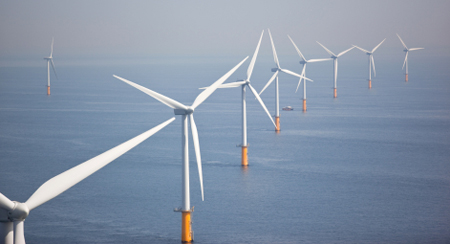
(Photo credit: iStockphotos.com)
Full-scale experimental research on floating wind turbines has started in Japan. In March, a consortium of 10 Japanese companies including Marubeni and the University of Tokyo was awarded a contract for experimental research by the Ministry of Economy, Trade and Industry.
In the first phase of the project, which will start this year, a 2MW floating wind turbine and a floating transformer station will be installed off the coast of Fukushima prefecture. Two 7MW wind turbines will then be added in the second phase from 2013 to 2015. The research aims to establish a business model for floating offshore wind power generation and to develop it into one of Japan's major export industries.
Offshore wind turbine projects are becoming a centre of focus these days, mainly due to reduced availability of space onshore and technological limit of enlarging turbine sizes for efficiency. Large-scale offshore projects are already ongoing in Europe, particularly in the UK. China also launched a 100MW wind farm after the Shanghai Expo, and aims to achieve 5GW by 2015.
Virgin frontier
It may, however, look quite challenging for Japan, which has only limited experiences of offshore technologies as opposed to international rivals, to attempt to establish floating offshore wind turbine technologies. For one thing it is because Japan must use the floating type to utilise offshore wind resources since the deep seas surrounding Japan limit the installation of bottom-fixed systems.
In fact, at the test sites 20-40km offshore, the water is as deep as 100-150m. Another reason strategically more important is that Japanese turbine makers are far behind major competitors in the land based turbine market. Japanese turbine manufacturers have only a 3 percent share of the world market and only a 20 percent share even in the domestic market.
Challenging the virgin frontier will be the only way to allow Japan to start from the same position as rival countries.
It is the case with solar panels as well. Following the Sunshine Plan of the 1970s, Japan was a world leader in the solar panel industry until the early 2000s, but now lags far behind China which was late to enter this business. As far as crystalline silicon-based technologies dominate the solar panel market, chances are very slim that Japanese players would overcome the situation. Japan, therefore, must seek opportunities in the field of next-generation technologies such as quantum dot and dye-sensitised solar cells.
The good news is that the University of Tokyo recently set new records for conversion efficiency in the areas. Japan's future in renewable energy industry lies in the new frontiers.

BY : Hiroshi Hashimoto, the Institute of Energy Economics, Japan (IEEJ)